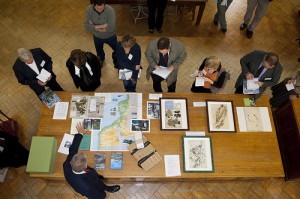Kew and IUCN made a splash today with the Sampled Red List Index for Plants. A representative sample of 7,000 species of plants was selected from the comprehensive IUCN Red List Index for detailed monitoring. 1 You can contribute to the Sampled Red List in a wiki-like environment, and follow its progress on the inevitable blog. An interactive map allows some basic exploration of the data. The headline number is that 25% of plant species are threatened. There are various crop wild relatives among the 7,000 species, 2 so it might be possible to calculate some statistics for that particular category, to complement other efforts.

What are species worth?
…wild species continue to be the mother lode of genetic material for making agricultural crops more productive, or more resistant to pests, disease, and drought.
Well, it’s not much, and the few, admittedly unsatisfactory, figures we have on their monetary value are not quoted, but it is good to see crop wild relatives mentioned so explicitly in a discussion of the value of biodiversity.
Nibbles: Pavlovsk, Baobab hybridization, Jackfruit, Vavilovia, Cowpea education, Lead, Bees, Banana wilt, Dariy cows, Pavlovsk, Drylands, School gardens, Genetic diversity in botanic gardens
- The value of Pavlovsk. Jeremy delivers a slap.
- CIRAD on kinky sex among the baobabs.
- “I had never heard that there were distinct varieties of the jackfruit, although of course such a thing was reasonable, so I naturally wanted very much to taste one.” Naturally.
- Wild relative of pea gets a weird hybrid in-ex situ conservation treatment.
- A Cowpea Story, an illustrative children’s book by Vicky Inniss-Palmer, tells the hopeful story of a cowpea named Catalina and her struggle to overcome illness and disease with the help of scientists. Meanwhile, scientists meet.
- Urban gardeners, beware lead. And nurture your pollinators.
- Reading this, anyone would think nobody had ever researched banana Xanthomonas wilt.
- Improved dairying in Kenya.
- Vavilov Institute’s comprehensive update on Pavlovsk.
- ICRISAT to put in place new market-oriented strategy which will use a “systems perspective in setting our priorities to ensure that all important issues along the dryland agriculture value chain are addressed.”
- Meanwhile, ASARECA asks for ideas on how to intensify one of those dryland systems in the face of climate change.
- ICIMOD promotes herbal gardens in schools.
- Botanic gardens get wrists slapped over their inattention to genetics.
Nibbles: Genebank, Guanaco, Maize, Wild food
- Maintaining a citrus gene bank. Just the book you need if you have to, er, maintain a citrus genebank.
- Guanacos need quiet.
- Don’t understand this piece on maize germplasm conservation and use.
- Indigenous food plants in trouble in the Philippines.
Brassica bounty
Couldn’t resist today’s trifecta of Brassica papers. At the meta level, there’s “Origin and Domestication of Cole Crops (Brassica oleracea L.): Linguistic and Literary Considerations” in Economic Botany. Then some of the same authors follow up in GRACE with “AFLP analysis of genetic diversity in leafy kale (Brassica oleracea L. convar. acephala (DC.) Alef.) landraces, cultivars and wild populations in Europe.” And finally, in Plant Breeding, enjoy “The cytoplasm effect comparison between Brassica napus and Brassica carinata on floral characteristics of Brassica oleracea.” Enough to keep brassica boffins busy for weeks.